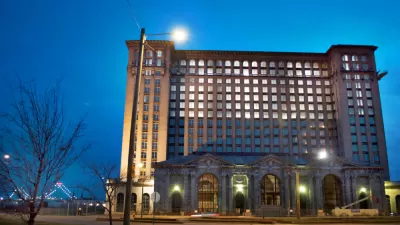This article from Developer looks at five cities that are dealing creatively with their foreclosure and abandonment problems.
"Estimates vary, but foreclosure listing company RealtyTrac approximated 261,255 homes in foreclosure in May of this year, almost double the number in May 2007. The Brookings Institution estimates that vacant and abandoned properties of all kinds- whether from foreclosure or not-occupy about 15 percent of a typical large city, an average of 12,000 acres."
"'The first wave [of abandoned properties due to foreclosure] has probably landed, but if we use the tsunami metaphor, it's the second and third waves that are larger and more dangerous,' says Joe Schilling, professor of urban affairs and planning at Virginia Tech's Alexandria Center."
"The best way to fight the tide, he says, is for each community and neighborhood to develop its own strategy based on the local economy and housing market. Schilling recommends that the redevelopment of large numbers of abandoned buildings happen in three phases. First, cities must stabilize neighborhoods by either demolishing vacant properties or acquiring them for redevelopment. Next, officials must establish a plan that focuses on how to reclaim vacant properties at the neighborhood level. Finally, cities must offer incentives-perks such as tax credits or expedited permitting-in order to lure back private developers and investors who would otherwise be disinterested."
"Developer identified five cities that are putting such forward-thinking plans into action. These governments are working with the real estate community to turn around abandoned sites-and offering incentives to entice developers to enter these troubled and neglected neighborhoods."
The five cities:
- Buffalo, NY
- Carbondale, PA
- Cleveland, OH
- Flagstaff, AZ
- Los Angeles, CA
FULL STORY: Sign of the Times - Five cities bringing new life to abandoned sites

Planetizen Federal Action Tracker
A weekly monitor of how Trump’s orders and actions are impacting planners and planning in America.

Map: Where Senate Republicans Want to Sell Your Public Lands
For public land advocates, the Senate Republicans’ proposal to sell millions of acres of public land in the West is “the biggest fight of their careers.”

Restaurant Patios Were a Pandemic Win — Why Were They so Hard to Keep?
Social distancing requirements and changes in travel patterns prompted cities to pilot new uses for street and sidewalk space. Then it got complicated.

Platform Pilsner: Vancouver Transit Agency Releases... a Beer?
TransLink will receive a portion of every sale of the four-pack.

Toronto Weighs Cheaper Transit, Parking Hikes for Major Events
Special event rates would take effect during large festivals, sports games and concerts to ‘discourage driving, manage congestion and free up space for transit.”

Berlin to Consider Car-Free Zone Larger Than Manhattan
The area bound by the 22-mile Ringbahn would still allow 12 uses of a private automobile per year per person, and several other exemptions.
Urban Design for Planners 1: Software Tools
This six-course series explores essential urban design concepts using open source software and equips planners with the tools they need to participate fully in the urban design process.
Planning for Universal Design
Learn the tools for implementing Universal Design in planning regulations.
Heyer Gruel & Associates PA
JM Goldson LLC
Custer County Colorado
City of Camden Redevelopment Agency
City of Astoria
Transportation Research & Education Center (TREC) at Portland State University
Camden Redevelopment Agency
City of Claremont
Municipality of Princeton (NJ)




























